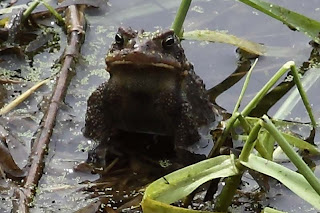
I belatedly checked the birdhouses this morning, and results were somewhat as expected and somewhat surprising. The tree swallows we covered last week did not take occupancy of the bottom field west birdhouse. However, those bluebirds they were keeping their eye on did establish a nest in the house to the east, and this morning, after opening the top of the house and then finally getting mom to temporarily leave the nest, the five pale blue eggs were visible (image above left). Five is very common for bluebirds, and incubation time is 13-15 days, so although I'm not sure how long it has been since she laid these, let's say hatching might occur in about a week.
Moving to the upper field, I approached the house there and a nuthatch flew out before I got very close. Apparently, she is a bit more nervous than the bluebird. The nest (image above right) is a two tier affair, with a deep mass of short green grass pieces (I've mowed a couple times around there recently) and some drier grass and hair(?) on top. Looked pretty soft to me! A count of five eggs is in the lower range for the nuthatch (usually 5-10, commonly 8), and incubation time is 12 days. Unlike bluebirds, the nuthatch pair will only have one brood this season. We'll keep looking, and maybe catch a picture of some newborns.
Spring is such an amazing season. These things happen every year, and it's new each time!
Spring is such an amazing season. These things happen every year, and it's new each time!
























